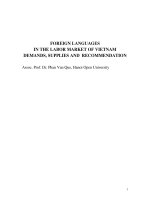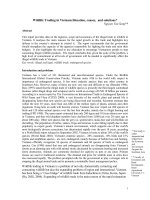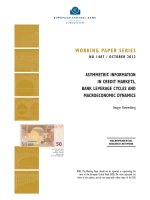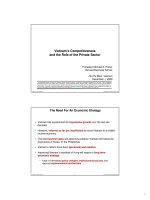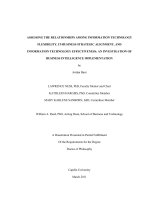Project Information Document (Appraisal Stage) - Vietnam Dam Rehabilitation and Safety Improvement Project
Bạn đang xem bản rút gọn của tài liệu. Xem và tải ngay bản đầy đủ của tài liệu tại đây (25.72 KB, 7 trang )
Page 1 of 7
Public Disclosure CopyPublic Disclosure Copy
PROJECT INFORMATION DOCUMENT (PID)
APPRAISAL STAGE
Report No.: PIDA28117
Project Name
Vietnam Dam Rehabilitation and Safety Improvement Project
(P152309)
Region
EAST ASIA AND PACIFIC
Country
Vietnam
Sector(s)
Irrigation and drainage (35%), Energy efficiency in Heat and
Power (30%), Water supply (30%), Public administration- Water,
sanitati on and flood protection (5%)
Theme(s)
Natural disaster management (35%), Water resource management
(30%), Rural services and infrastructure (25%), Infrastructure
services for private sector development (10%)
Lending Instrument
Investment Project Financing
Project ID
P152309
Borrower(s)
Vietnam Ministry of Agriculture and Rural Development
Implementing Agency
Central Project Office
Environmental Category
A-Full Assessment
Date PID Prepared/Updated
12-Aug-2015
Date PID Approved/Disclosed
12-Aug-2015
Estimated Date of Appraisal
Completion
11-Aug-2015
Estimated Date of Board
Approval
29-Sep-2015
Appraisal Review Decision
(from Decision Note)
I. Project Context
Country Context
1. Vietnam has experienced a rapid economic growth over the past two decades. Political and
economic reforms launched in 1986 have transformed Vietnam from one of the poorest countries in
the world, with per capita income below US$100, to a lower-middle income country within a
quarter of a century, per capita income reaching US$1,790 by the end of 2014. The poverty
headcount ratio has fallen from 58 percent in 1993 to 17.2 percent in 2013, and most indicators of
welfare have improved. Vietnam has been applauded for the equity of its development, which ranks
better compared with other countries in similar context. Five of the ten original Millennium
Development Goal targets have already been attained.
2. Vietnam is an agriculture-based economy and a county most exposed to natural hazards.
These risks pose a challenge for Vietnam’s quest for continued growth, given the geography,
Page 2 of 7
Public Disclosure CopyPublic Disclosure Copy
topography, economic structure and population distribution making the country highly vulnerable.
While floods and typhoons are the dominant hazards, the country is also susceptible to droughts,
landslides and seawater intrusion, particularly during the monsoon rainy season combined with
river plain flooding and flash floods, as well as associated land-slides. The risks associated with
these hazards are being further exacerbated due to the impacts of climate change. Recent experience
has illustrated the increasing financial vulnerability from extreme weather events, accentuated by
the density of physical and commercial activities in vulnerable areas. The agriculture sector is
particularly vulnerable to climate risk and is being heavily dependent on irrigation, drainage and
flood control with a high density infrastructure network distributed across 14 major river basins
throughout the country.
3. Significant resources have been invested in ensuring water security. Water-related
expenditures accounted for an estimated 22.9 percent (US$ 1,140.57 million) of total Government
expenditure during the period of 2001 to 2011. Over half of the Government expenditures were
channeled into hydroelectric power plants (50.6 percent), followed by water supply and sanitation
(27.8 percent) and agricultural water resources (17.3 percent). During this same period, official
development assistance (ODA) gross disbursements in the sector on average amounted to US$
240.52 million per year, with close to half of ODA disbursements going to water supply and
sanitation (46.8 percent). As a result of these investments, Vietnam has one of the world’s most
extensive network of dams and hydraulic infrastructure with a combined storage capacity of about
50 billion cubic meters, similar to that of France, Germany and Australia. While the primary
development has been for irrigation and hydropower, many of these dams are multi-purpose,
supporting flood regulation, aquaculture and bulk of water supply. While these investments have
provided an effective infrastructure platform to ensure water security and meet historical demands,
increasing impacts associated with a changing climate, the frequency of natural disasters and
increased demand resulting from rapid economic development are undermining the existing dams
and hydraulic infrastructure and accentuating uncoordinated operational procedures.
4. With over 7,000 dams of different types and sizes Vietnam has a complex and evolving
institutional framework for dam safety. There are more than 750 large dams , with the number of
small dams estimated to be in excess of 6,000. These are largely earth embankment dams
supporting irrigation of more than three million of the total four million hectares of agricultural
land. These irrigation dams fall under the Ministry of Agriculture and Rural Development (MARD)
and are managed through the Provincial structures, with the exception of one inter-provincial dam
managed at the central level. At the provincial level all large and medium-size dams are managed
by provincial Irrigation Management Companies (IMCs) while small dams are entrusted by IMC to
local communities for operations and maintenance. In addition, there are more than 1,100
hydropower dams either under operation, construction, investigation or planned that fall under the
Ministry of Industry and Trade (MoIT). The existing 268 hydropower dams have a total installed
capacity of 13,066 MW. Of these, 86 are defined as large hydropower dams, with an installed
capacity greater than 30 MW, managed through Electricity of Vietnam (EVN), the state owned
power utility, or other state-owned hydropower companies. In contrast, most of the small
hydropower facilities (<30MW) are developed, owned and operated by the private sector.
Table 1: Summary of the Dam network in Vietnam
Definition Irrigation Hydro-power
Dams > 50m 3 32
Dams 15m – 50m or >=3 MCM 551 54
Page 3 of 7
Public Disclosure CopyPublic Disclosure Copy
Dams <15m & < 3 MCM 6,648 201
5. The development of this extensive network of hydraulic infrastructure has resulted in a
number of inherent challenges. Many of the medium and small-size reservoirs were built in the
1960s-1980s with limited technical investigations, inadequate design, and poor construction quality.
These issues have been compounded by limited investments in operations and deferred
maintenance, as the public sector irrigation dams are financed through Government transfers which
are often insufficient and untimely. As a result, many dams have deteriorated, posing a substantial
risk to human safety and economic security, with structural and non-structural safety often falling
below acceptable international standards. The deterioration of these dams, coupled with increased
risk and uncertainty resulting from hydrological v ariability due to climate change and rapid
upstream development, has placed many reservoirs at risk.
6. Failure to secure the operational safety of the existing hydraulic networks and strengthening
the capacity for further development has the potential to undermine Vietnam’s economic gains. The
cost of damages associated with water-related disasters have been estimated at VDN 18,700 billion
(US$ 1.25 billion) between 1995 and 2002. In the past five years, there have been an estimated 30
dam failures. These have resulted in devastating regional flooding, significant loss of human life,
and substantial economic losses. The impacts associated with natural flooding have been further
exacerbated by the uncoordinated operation along cascades of dams within individual river basins
and the limited capacity for timely monitoring and forecasting of high flows, particularly in the
narrow and steep topography of the Central Highlands. The public outcry resulting from recurrent
flooding and dam failure has been echoed by the media and has led to civil society campaigns
which have raised the awareness of this problem in all spheres of Government.
7. The Government has established a sectoral program for dam safety in recognition of the
importance of securing the foundations for sustained and secure economic growth. The program
was first launched in 2003, revised again in 2009 and has been revisited in 2015 as part of the effort
to revitalize the program activities and targets. Based on information available from MARD, there
are about 1,150 irrigation dams in need of urgent rehabilitation or upgrading until 2022. By
contrast, the physical conditions of the large hydropower dams under the operation of the national
utility are reported as safe. The program recognizes the need to improve not only the physical
stability of dam facilities, but also the safety management system including the legal and regulatory
framework, technical standards, norms, guidelines, manuals as well as building capacity. The
program is currently being led by MARD in collaboration with the MoIT, the Ministry of Natural
Resources and Environment (MoNRE) and Provincial authorities with budget support from the
national Government. The total cost of the program is estimated to be over VND21.3 trillion
(approx. US$1.0 billion). In support of this renewed effort, the Government has allocated an
amount of VND900 billion (approximately US$38 million) since 2013 to rehabilitate about 90
dams. The number of dams rehabilitated annually is about 50, with an average cost of US$400,000.
While sufficient technical capacity exists to rehabilitate a large number of dams, the current
program is constrained by resource availability.
Sectoral and institutional Context
8. Vietnam’s legislation governing the water sector consists of a complex system of legal
instruments issued by different state agencies. The institutional responsibilities are divided between
MARD, which is responsible for publicly financed irrigation dams while MoIT oversees the
Page 4 of 7
Public Disclosure CopyPublic Disclosure Copy
hydropower facilities. The Law on Water Resources approved in 2012 and became effective on
January 2013 assigns MoNRE within the evolving institutional framework with responsibility for
inter-reservoir operations in those basins with cascades of dams. The Law is aligned with principles
of Integrated Water Resources Management (IWRM), with an emphasis on the introduction of river
basin approaches, including provisions for improving dam safety and reservoirs, as well as
introducing provision for the introduction of environmental flows. The national legal framework for
dam safety is prescribed through Decree No. 72, issued in May 2007 and revised to define a set of
dam safety related issues . However, oversight of dam operations and performance by central
ministries and provincial authorities is constrained by lack of capacity, both in terms of number and
skilled qualifications, further undermined by the lack of technical standards, norms, safety
inspection guidelines and procedures. The roles and responsibilities of the various Government
agencies are outlined in a series of Government Circulars. These were formulated and came into
effect to direct dam safety and reservoir management and include provisions for inter-reservoir
water regulation plans covering serious drought, water contamination, environmental incidents, or
disasters. The decrees and circulars also define the roles and responsibilities of provincial and
district level organizations and other relevant entities.
9. The rapid development of hydraulic infrastructure is increasing the institutional complexity
within various river basins. This evolving context requires similar changes in the regulatory regime
to clearly delineate responsibilities and provide the mechanisms to balance the competing demands
of the different state agencies. The operation and maintenance (O&M) of medium and large-size
irrigation dams is the responsibility of the provincial irrigation management companies (IMCs) with
branch offices at district level. The O&M of small dams is typically the responsibility of the local
authorities acting through its Agricultural Cooperatives or irrigation brigades. While the technical
capacity of the IMCs is generally good and sufficient to meet the minimum management
responsibilities, the capacity of the local authorities is limited, necessitating significant support and
guidance from technical agencies at the provincial and district level. In contrast, the responsibility
for the O&M of hydropower dams rests with its owners, although often without regular monitoring
by administrative agencies. The state-owned corporations responsible for O&M of the large and
medium-size hydropower dams have sufficient technical expertise to perform their tasks. However,
the private-sector investors developing the smaller hydropower dams often lack the technical
expertise to manage these facilities. This poses a number of safety risks, especially during the flood
season. Strengthening the institutional arrangement to ensure more effective dam safety and
reservoir management is a core Government objective that will be supported by the project.
10. There are estimated to be at least 104 different entities responsible for managing irrigation
and drainage systems across Vietnam. These include 90 Provincial IMCs under PPCs in 49 of the
country’s 63 provinces employing over 24,000 staff. The IMCs are state owned enterprises
responsible for operations and maintenance for irrigation facilities including dams at the provincial
level with branch offices at the district level Irrigation Management Enterprises (IMEs). In addition,
there are three MARD IMCs in charge of large inter-provincial irrigation schemes that operate
across 11 provinces. In the remaining 14 provinces where there are no IMCs, irrigation and
drainage systems are managed by a range of different institutions, including Irrigation Management
Centers, Irrigati on Management Boards, Water Resources Division of the Provincial Departments
of Agriculture and Rural Development (DARDs). These 14 provinces are mainly in the Mekong
Delta where irrigation schemes do not rely on reservoir storage. Typically, responsibility for
reservoirs less than 1MCM in the lowland areas and 500,000m3 in the highlands are delegated to
the District or Commune level. The DARDs are responsible for overseeing the O&M, monitoring
Page 5 of 7
Public Disclosure CopyPublic Disclosure Copy
performance and regulation of irrigation at the provincial level under the guidance of the PPCs.
11. The Provincial People’s Committees (PPC) are responsible for guiding and monitoring the
operation of dams and reservoirs, and the execution of safety plans during disaster events. The
O&M of the dams, along with emergency preparedness procedures and overall dam safety measures
are prescribed in the Provincial Flood Prevention and Protection Plans. These are the responsibility
of the PPC in accordance with the provisions of Decree No. 72. These plans are compiled and
carried out in coordination with MARD, MoNRE, and MoIT, along with the Steering Committees
for Natural Disaster Prevention and Control, which is led by the Minister MARD. Insufficient funds
and delays in the release of the annual budgets for O&M implies that such plans are not fully
implemented, resulting in the deterioration of many dams. This is particularly problematic for small
dams managed by the local communities. Lack of safety monitoring devices, unclear reporting
procedures and the absence of a robust institutional framework for coordination further undermine
dam safety operations and expose many downstream communities and economic activities to
significant risks.
II. Proposed Development Objectives
The Project Development Objective is to improve the safety of dams under the Government’s Dam
Safety Program to protect downstream communities and economic activities through priority
investments and institutional enhancements.
III. Project Description
Component Name
1. Dam Safety Rehabilitation
Comments (optional)
Component Name
2. Dam Safety Management
Comments (optional)
Component Name
3. Project Management Support
Comments (optional)
IV. Financing (in USD Million)
Total Project Cost: 455.00 Total Bank Financing: 420.00
Financing Gap: 0.00
For Loans/Credits/Others Amount
BORROWER/RECIPIENT 35.00
International Development Association (IDA) 420.00
Total 455.00
Page 6 of 7
Public Disclosure CopyPublic Disclosure Copy
V. Implementation
VI. Safeguard Policies (including public consultation)
Safeguard Policies Triggered by the Project Yes No
Environmental Assessment OP/BP 4.01
✖
Natural Habitats OP/BP 4.04
✖
Forests OP/BP 4.36
✖
Pest Management OP 4.09
✖
Physical Cultural Resources OP/BP 4.11
✖
Indigenous Peoples OP/BP 4.10
✖
Involuntary Resettlement OP/BP 4.12
✖
Safety of Dams OP/BP 4.37
✖
Projects on International Waterways OP/BP 7.50
✖
Projects in Disputed Areas OP/BP 7.60
✖
Comments (optional)
VII. Contact point
World Bank
Contact: Cuong Hung Pham
Title: Sr Water Resources Spec.
Tel: 5777+7308 /
Email:
Contact: Marcus J. Wishart
Title: Sr Water Resources Spec.
Tel: 5369+3147
Email:
Borrower/Client/Recipient
Name: Vietnam Ministry of Agriculture and Rural Development
Contact: Mr. Tran Kim Long
Title: Gen. Director of ICD
Tel: 84-913218121
Email:
Implementing Agencies
Name: Central Project Office
Contact: Mr. Nguyen Canh Tinh
Title: Project Director
Tel: 84-913218121
Email:
Page 7 of 7
Public Disclosure CopyPublic Disclosure Copy
VIII.For more information contact:
The InfoShop
The World Bank
1818 H Street, NW
Washington, D.C. 20433
Telephone: (202) 458-4500
Fax: (202) 522-1500
Web: />
